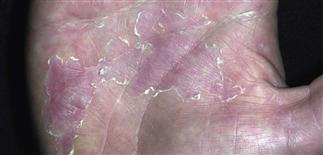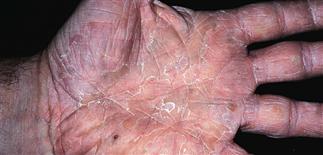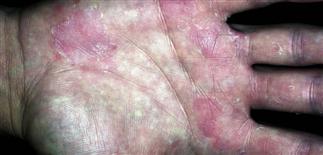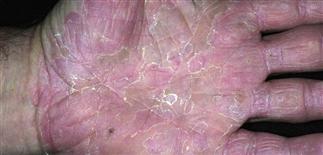Keratolysis exfoliativa

The palm is barely erythematous, with a serpiginous light desquamation. Itching is not typical. Potassium hydroxide testing of the scale is negative.

A severe form that recurred two or three times each year. Palms were painful.

Fingers showing fine scaling and no erythema. This scaling is often recurrent and occurs in waves. The cause is unknown.

Palmar erythema, dryness, increased markings, and fine ring-like arrangements of scaling are present. This benign condition often responds well to frequent emollient use.
DESCRIPTION
Keratolysis exfoliativa is a common, chronic, asymptomatic, non-inflammatory, symmetric peeling of palms and soles. The cause is unknown.
HISTORY
• Occurs most commonly during summer. • Often associated with sweaty palms and soles. • Some people have repeated episodes; others experience this phenomenon only once. • Resolves in 1–3 weeks but may recur. • Improves with moisturization and generally resolves with age.
PHYSICAL FINDINGS
• Scaling starts simultaneously from several points on the palms or soles with 2–3-mm of round scale that appears to have originated from a ruptured vesicle; however, vesicles are not seen. • Scales continue to peel and extend peripherally, forming larger, roughly circular areas that resemble ringworm. The central area becomes slightly red and, in a few cases, tender. • Scaling borders may coalesce. • A potassium hydroxide examination is worthwhile to exclude tinea infection.
TREATMENT
No therapy other than lubrication is required.







